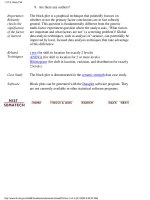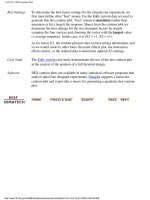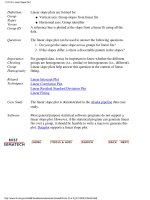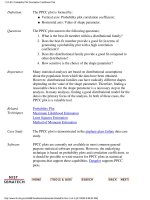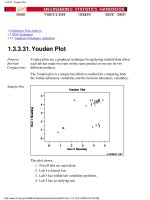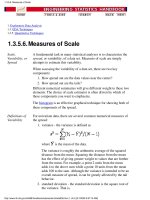Engineering Statistics Handbook Episode 1 Part 13 doc
Bạn đang xem bản rút gọn của tài liệu. Xem và tải ngay bản đầy đủ của tài liệu tại đây (72.05 KB, 20 trang )
correlation coefficient plot and the probability plot are useful tools for
determining a good distributional model for the data.
Software The skewness and kurtosis coefficients are available in most general
purpose statistical software programs, including Dataplot.
1.3.5.11. Measures of Skewness and Kurtosis
(4 of 4) [5/1/2006 9:57:21 AM]
Sample Output Dataplot generated the following autocorrelation output using the
LEW.DAT data set:
THE LAG-ONE AUTOCORRELATION COEFFICIENT OF THE
200 OBSERVATIONS = -0.3073048E+00
THE COMPUTED VALUE OF THE CONSTANT A = -0.30730480E+00
lag autocorrelation
0. 1.00
1. -0.31
2. -0.74
3. 0.77
4. 0.21
5. -0.90
6. 0.38
7. 0.63
8. -0.77
9. -0.12
10. 0.82
11. -0.40
12. -0.55
13. 0.73
14. 0.07
15. -0.76
16. 0.40
17. 0.48
18. -0.70
19. -0.03
20. 0.70
21. -0.41
22. -0.43
23. 0.67
24. 0.00
25. -0.66
26. 0.42
27. 0.39
28. -0.65
29. 0.03
30. 0.63
31. -0.42
32. -0.36
33. 0.64
34. -0.05
35. -0.60
36. 0.43
37. 0.32
38. -0.64
39. 0.08
40. 0.58
1.3.5.12. Autocorrelation
(2 of 4) [5/1/2006 9:57:45 AM]
41. -0.45
42. -0.28
43. 0.62
44. -0.10
45. -0.55
46. 0.45
47. 0.25
48. -0.61
49. 0.14
Questions The autocorrelation function can be used to answer the following
questions
Was this sample data set generated from a random process?1.
Would a non-linear or time series model be a more appropriate
model for these data than a simple constant plus error model?
2.
Importance
Randomness is one of the key assumptions in determining if a
univariate statistical process is in control. If the assumptions of
constant location and scale, randomness, and fixed distribution are
reasonable, then the univariate process can be modeled as:
where E
i
is an error term.
If the randomness assumption is not valid, then a different model needs
to be used. This will typically be either a time series model or a
non-linear model (with time as the independent variable).
Related
Techniques
Autocorrelation Plot
Run Sequence Plot
Lag Plot
Runs Test
Case Study
The heat flow meter data demonstrate the use of autocorrelation in
determining if the data are from a random process.
The beam deflection data demonstrate the use of autocorrelation in
developing a non-linear sinusoidal model.
Software The autocorrelation capability is available in most general purpose
statistical software programs, including Dataplot.
1.3.5.12. Autocorrelation
(3 of 4) [5/1/2006 9:57:45 AM]
1.3.5.12. Autocorrelation
(4 of 4) [5/1/2006 9:57:45 AM]
run of length r is r consecutive heads or r consecutive tails. To use the
Dataplot RUNS command, you could code a sequence of the N = 10 coin
tosses HHHHTTHTHH as
1 2 3 4 3 2 3 2 3 4
that is, a heads is coded as an increasing value and a tails is coded as a
decreasing value.
Another alternative is to code values above the median as positive and values
below the median as negative. There are other formulations as well. All of
them can be converted to the Dataplot formulation. Just remember that it
ultimately reduces to 2 choices. To use the Dataplot runs test, simply code
one choice as an increasing value and the other as a decreasing value as in the
heads/tails example above. If you are using other statistical software, you
need to check the conventions used by that program.
Sample Output
Dataplot generated the following runs test output using the LEW.DAT data
set:
RUNS UP
STATISTIC = NUMBER OF RUNS UP
OF LENGTH EXACTLY I
I STAT EXP(STAT) SD(STAT) Z
1 18.0 41.7083 6.4900 -3.65
2 40.0 18.2167 3.3444 6.51
3 2.0 5.2125 2.0355 -1.58
4 0.0 1.1302 1.0286 -1.10
5 0.0 0.1986 0.4424 -0.45
6 0.0 0.0294 0.1714 -0.17
7 0.0 0.0038 0.0615 -0.06
8 0.0 0.0004 0.0207 -0.02
9 0.0 0.0000 0.0066 -0.01
10 0.0 0.0000 0.0020 0.00
STATISTIC = NUMBER OF RUNS UP
OF LENGTH I OR MORE
I STAT EXP(STAT) SD(STAT) Z
1 60.0 66.5000 4.1972 -1.55
2 42.0 24.7917 2.8083 6.13
1.3.5.13. Runs Test for Detecting Non-randomness
(2 of 5) [5/1/2006 9:57:45 AM]
3 2.0 6.5750 2.1639 -2.11
4 0.0 1.3625 1.1186 -1.22
5 0.0 0.2323 0.4777 -0.49
6 0.0 0.0337 0.1833 -0.18
7 0.0 0.0043 0.0652 -0.07
8 0.0 0.0005 0.0218 -0.02
9 0.0 0.0000 0.0069 -0.01
10 0.0 0.0000 0.0021 0.00
RUNS DOWN
STATISTIC = NUMBER OF RUNS DOWN
OF LENGTH EXACTLY I
I STAT EXP(STAT) SD(STAT) Z
1 25.0 41.7083 6.4900 -2.57
2 35.0 18.2167 3.3444 5.02
3 0.0 5.2125 2.0355 -2.56
4 0.0 1.1302 1.0286 -1.10
5 0.0 0.1986 0.4424 -0.45
6 0.0 0.0294 0.1714 -0.17
7 0.0 0.0038 0.0615 -0.06
8 0.0 0.0004 0.0207 -0.02
9 0.0 0.0000 0.0066 -0.01
10 0.0 0.0000 0.0020 0.00
STATISTIC = NUMBER OF RUNS DOWN
OF LENGTH I OR MORE
I STAT EXP(STAT) SD(STAT) Z
1 60.0 66.5000 4.1972 -1.55
2 35.0 24.7917 2.8083 3.63
3 0.0 6.5750 2.1639 -3.04
4 0.0 1.3625 1.1186 -1.22
5 0.0 0.2323 0.4777 -0.49
6 0.0 0.0337 0.1833 -0.18
7 0.0 0.0043 0.0652 -0.07
8 0.0 0.0005 0.0218 -0.02
9 0.0 0.0000 0.0069 -0.01
10 0.0 0.0000 0.0021 0.00
1.3.5.13. Runs Test for Detecting Non-randomness
(3 of 5) [5/1/2006 9:57:45 AM]
RUNS TOTAL = RUNS UP + RUNS DOWN
STATISTIC = NUMBER OF RUNS TOTAL
OF LENGTH EXACTLY I
I STAT EXP(STAT) SD(STAT) Z
1 43.0 83.4167 9.1783 -4.40
2 75.0 36.4333 4.7298 8.15
3 2.0 10.4250 2.8786 -2.93
4 0.0 2.2603 1.4547 -1.55
5 0.0 0.3973 0.6257 -0.63
6 0.0 0.0589 0.2424 -0.24
7 0.0 0.0076 0.0869 -0.09
8 0.0 0.0009 0.0293 -0.03
9 0.0 0.0001 0.0093 -0.01
10 0.0 0.0000 0.0028 0.00
STATISTIC = NUMBER OF RUNS TOTAL
OF LENGTH I OR MORE
I STAT EXP(STAT) SD(STAT) Z
1 120.0 133.0000 5.9358 -2.19
2 77.0 49.5833 3.9716 6.90
3 2.0 13.1500 3.0602 -3.64
4 0.0 2.7250 1.5820 -1.72
5 0.0 0.4647 0.6756 -0.69
6 0.0 0.0674 0.2592 -0.26
7 0.0 0.0085 0.0923 -0.09
8 0.0 0.0010 0.0309 -0.03
9 0.0 0.0001 0.0098 -0.01
10 0.0 0.0000 0.0030 0.00
LENGTH OF THE LONGEST RUN UP = 3
LENGTH OF THE LONGEST RUN DOWN = 2
LENGTH OF THE LONGEST RUN UP OR DOWN = 3
NUMBER OF POSITIVE DIFFERENCES = 104
NUMBER OF NEGATIVE DIFFERENCES = 95
NUMBER OF ZERO DIFFERENCES = 0
1.3.5.13. Runs Test for Detecting Non-randomness
(4 of 5) [5/1/2006 9:57:45 AM]
Interpretation of
Sample Output
Scanning the last column labeled "Z", we note that most of the z-scores for
run lengths 1, 2, and 3 have an absolute value greater than 1.96. This is strong
evidence that these data are in fact not random.
Output from other statistical software may look somewhat different from the
above output.
Question The runs test can be used to answer the following question:
Were these sample data generated from a random process?
●
Importance Randomness is one of the key assumptions in determining if a univariate
statistical process is in control. If the assumptions of constant location and
scale, randomness, and fixed distribution are reasonable, then the univariate
process can be modeled as:
where E
i
is an error term.
If the randomness assumption is not valid, then a different model needs to be
used. This will typically be either a times series model or a non-linear model
(with time as the independent variable).
Related
Techniques
Autocorrelation
Run Sequence Plot
Lag Plot
Case Study
Heat flow meter data
Software
Most general purpose statistical software programs, including Dataplot,
support a runs test.
1.3.5.13. Runs Test for Detecting Non-randomness
(5 of 5) [5/1/2006 9:57:45 AM]
Significance
Level:
Critical
Region:
The critical values for the Anderson-Darling test are dependent
on the specific distribution that is being tested. Tabulated values
and formulas have been published (Stephens, 1974, 1976, 1977,
1979) for a few specific distributions (normal, lognormal,
exponential, Weibull, logistic, extreme value type 1). The test is
a one-sided test and the hypothesis that the distribution is of a
specific form is rejected if the test statistic, A, is greater than the
critical value.
Note that for a given distribution, the Anderson-Darling statistic
may be multiplied by a constant (which usually depends on the
sample size, n). These constants are given in the various papers
by Stephens. In the sample output below, this is the "adjusted
Anderson-Darling" statistic. This is what should be compared
against the critical values. Also, be aware that different constants
(and therefore critical values) have been published. You just
need to be aware of what constant was used for a given set of
critical values (the needed constant is typically given with the
critical values).
Sample
Output
Dataplot generated the following output for the Anderson-Darling test. 1,000
random numbers were generated for a normal, double exponential, Cauchy,
and lognormal distribution. In all four cases, the Anderson-Darling test was
applied to test for a normal distribution. When the data were generated using a
normal distribution, the test statistic was small and the hypothesis was
accepted. When the data were generated using the double exponential, Cauchy,
and lognormal distributions, the statistics were significant, and the hypothesis
of an underlying normal distribution was rejected at significance levels of 0.10,
0.05, and 0.01.
The normal random numbers were stored in the variable Y1, the double
exponential random numbers were stored in the variable Y2, the Cauchy
random numbers were stored in the variable Y3, and the lognormal random
numbers were stored in the variable Y4.
***************************************
** anderson darling normal test y1 **
***************************************
ANDERSON-DARLING 1-SAMPLE TEST
THAT THE DATA CAME FROM A NORMAL DISTRIBUTION
1. STATISTICS:
NUMBER OF OBSERVATIONS = 1000
MEAN = 0.4359940E-02
1.3.5.14. Anderson-Darling Test
(2 of 5) [5/1/2006 9:57:46 AM]
STANDARD DEVIATION = 1.001816
ANDERSON-DARLING TEST STATISTIC VALUE = 0.2565918
ADJUSTED TEST STATISTIC VALUE = 0.2576117
2. CRITICAL VALUES:
90 % POINT = 0.6560000
95 % POINT = 0.7870000
97.5 % POINT = 0.9180000
99 % POINT = 1.092000
3. CONCLUSION (AT THE 5% LEVEL):
THE DATA DO COME FROM A NORMAL DISTRIBUTION.
***************************************
** anderson darling normal test y2 **
***************************************
ANDERSON-DARLING 1-SAMPLE TEST
THAT THE DATA CAME FROM A NORMAL DISTRIBUTION
1. STATISTICS:
NUMBER OF OBSERVATIONS = 1000
MEAN = 0.2034888E-01
STANDARD DEVIATION = 1.321627
ANDERSON-DARLING TEST STATISTIC VALUE = 5.826050
ADJUSTED TEST STATISTIC VALUE = 5.849208
2. CRITICAL VALUES:
90 % POINT = 0.6560000
95 % POINT = 0.7870000
97.5 % POINT = 0.9180000
99 % POINT = 1.092000
3. CONCLUSION (AT THE 5% LEVEL):
THE DATA DO NOT COME FROM A NORMAL DISTRIBUTION.
***************************************
** anderson darling normal test y3 **
***************************************
ANDERSON-DARLING 1-SAMPLE TEST
THAT THE DATA CAME FROM A NORMAL DISTRIBUTION
1. STATISTICS:
NUMBER OF OBSERVATIONS = 1000
MEAN = 1.503854
STANDARD DEVIATION = 35.13059
ANDERSON-DARLING TEST STATISTIC VALUE = 287.6429
ADJUSTED TEST STATISTIC VALUE = 288.7863
1.3.5.14. Anderson-Darling Test
(3 of 5) [5/1/2006 9:57:46 AM]
2. CRITICAL VALUES:
90 % POINT = 0.6560000
95 % POINT = 0.7870000
97.5 % POINT = 0.9180000
99 % POINT = 1.092000
3. CONCLUSION (AT THE 5% LEVEL):
THE DATA DO NOT COME FROM A NORMAL DISTRIBUTION.
***************************************
** anderson darling normal test y4 **
***************************************
ANDERSON-DARLING 1-SAMPLE TEST
THAT THE DATA CAME FROM A NORMAL DISTRIBUTION
1. STATISTICS:
NUMBER OF OBSERVATIONS = 1000
MEAN = 1.518372
STANDARD DEVIATION = 1.719969
ANDERSON-DARLING TEST STATISTIC VALUE = 83.06335
ADJUSTED TEST STATISTIC VALUE = 83.39352
2. CRITICAL VALUES:
90 % POINT = 0.6560000
95 % POINT = 0.7870000
97.5 % POINT = 0.9180000
99 % POINT = 1.092000
3. CONCLUSION (AT THE 5% LEVEL):
THE DATA DO NOT COME FROM A NORMAL DISTRIBUTION.
Interpretation
of the Sample
Output
The output is divided into three sections.
The first section prints the number of observations and estimates for the
location and scale parameters.
1.
The second section prints the upper critical value for the
Anderson-Darling test statistic distribution corresponding to various
significance levels. The value in the first column, the confidence level of
the test, is equivalent to 100(1-
). We reject the null hypothesis at that
significance level if the value of the Anderson-Darling test statistic
printed in section one is greater than the critical value printed in the last
column.
2.
The third section prints the conclusion for a 95% test. For a different
significance level, the appropriate conclusion can be drawn from the
table printed in section two. For example, for
= 0.10, we look at the
row for 90% confidence and compare the critical value 1.062 to the
3.
1.3.5.14. Anderson-Darling Test
(4 of 5) [5/1/2006 9:57:46 AM]
Anderson-Darling test statistic (for the normal data) 0.256. Since the test
statistic is less than the critical value, we do not reject the null
hypothesis at the
= 0.10 level.
As we would hope, the Anderson-Darling test accepts the hypothesis of
normality for the normal random numbers and rejects it for the 3 non-normal
cases.
The output from other statistical software programs may differ somewhat from
the output above.
Questions The Anderson-Darling test can be used to answer the following questions:
Are the data from a normal distribution?
●
Are the data from a log-normal distribution?●
Are the data from a Weibull distribution?●
Are the data from an exponential distribution?●
Are the data from a logistic distribution?●
Importance Many statistical tests and procedures are based on specific distributional
assumptions. The assumption of normality is particularly common in classical
statistical tests. Much reliability modeling is based on the assumption that the
data follow a Weibull distribution.
There are many non-parametric and robust techniques that do not make strong
distributional assumptions. However, techniques based on specific
distributional assumptions are in general more powerful than non-parametric
and robust techniques. Therefore, if the distributional assumptions can be
validated, they are generally preferred.
Related
Techniques
Chi-Square goodness-of-fit Test
Kolmogorov-Smirnov Test
Shapiro-Wilk Normality Test
Probability Plot
Probability Plot Correlation Coefficient Plot
Case Study
Airplane glass failure time data.
Software The Anderson-Darling goodness-of-fit test is available in some general purpose
statistical software programs, including Dataplot.
1.3.5.14. Anderson-Darling Test
(5 of 5) [5/1/2006 9:57:46 AM]
Test Statistic: For the chi-square goodness-of-fit computation, the data are divided
into k bins and the test statistic is defined as
where is the observed frequency for bin i and is the expected
frequency for bin i. The expected frequency is calculated by
where F is the cumulative Distribution function for the distribution
being tested, Y
u
is the upper limit for class i, Y
l
is the lower limit for
class i, and N is the sample size.
This test is sensitive to the choice of bins. There is no optimal choice
for the bin width (since the optimal bin width depends on the
distribution). Most reasonable choices should produce similar, but
not identical, results. Dataplot uses 0.3*s, where s is the sample
standard deviation, for the class width. The lower and upper bins are
at the sample mean plus and minus 6.0*s, respectively. For the
chi-square approximation to be valid, the expected frequency should
be at least 5. This test is not valid for small samples, and if some of
the counts are less than five, you may need to combine some bins in
the tails.
Significance Level:
.
Critical Region: The test statistic follows, approximately, a chi-square distribution
with (k - c) degrees of freedom where k is the number of non-empty
cells and c = the number of estimated parameters (including location
and scale parameters and shape parameters) for the distribution + 1.
For example, for a 3-parameter Weibull distribution, c = 4.
Therefore, the hypothesis that the data are from a population with
the specified distribution is rejected if
where is the chi-square percent point function with k - c
degrees of freedom and a significance level of
.
In the above formulas for the critical regions, the Handbook follows
the convention that
is the upper critical value from the
chi-square distribution and
is the lower critical value from the
chi-square distribution. Note that this is the opposite of what is used
in some texts and software programs. In particular, Dataplot uses the
opposite convention.
1.3.5.15. Chi-Square Goodness-of-Fit Test
(2 of 6) [5/1/2006 9:57:46 AM]
Sample
Output
Dataplot generated the following output for the chi-square test where 1,000 random
numbers were generated for the normal, double exponential, t with 3 degrees of freedom,
and lognormal distributions. In all cases, the chi-square test was applied to test for a
normal distribution. The test statistics show the characteristics of the test; when the data
are from a normal distribution, the test statistic is small and the hypothesis is accepted;
when the data are from the double exponential, t, and lognormal distributions, the
statistics are significant and the hypothesis of an underlying normal distribution is
rejected at significance levels of 0.10, 0.05, and 0.01.
The normal random numbers were stored in the variable Y1, the double exponential
random numbers were stored in the variable Y2, the t random numbers were stored in the
variable Y3, and the lognormal random numbers were stored in the variable Y4.
*************************************************
** normal chi-square goodness of fit test y1 **
*************************************************
CHI-SQUARED GOODNESS-OF-FIT TEST
NULL HYPOTHESIS H0: DISTRIBUTION FITS THE DATA
ALTERNATE HYPOTHESIS HA: DISTRIBUTION DOES NOT FIT THE DATA
DISTRIBUTION: NORMAL
SAMPLE:
NUMBER OF OBSERVATIONS = 1000
NUMBER OF NON-EMPTY CELLS = 24
NUMBER OF PARAMETERS USED = 0
TEST:
CHI-SQUARED TEST STATISTIC = 17.52155
DEGREES OF FREEDOM = 23
CHI-SQUARED CDF VALUE = 0.217101
ALPHA LEVEL CUTOFF CONCLUSION
10% 32.00690 ACCEPT H0
5% 35.17246 ACCEPT H0
1% 41.63840 ACCEPT H0
CELL NUMBER, BIN MIDPOINT, OBSERVED FREQUENCY,
AND EXPECTED FREQUENCY
WRITTEN TO FILE DPST1F.DAT
*************************************************
** normal chi-square goodness of fit test y2 **
*************************************************
1.3.5.15. Chi-Square Goodness-of-Fit Test
(3 of 6) [5/1/2006 9:57:46 AM]
CHI-SQUARED GOODNESS-OF-FIT TEST
NULL HYPOTHESIS H0: DISTRIBUTION FITS THE DATA
ALTERNATE HYPOTHESIS HA: DISTRIBUTION DOES NOT FIT THE DATA
DISTRIBUTION: NORMAL
SAMPLE:
NUMBER OF OBSERVATIONS = 1000
NUMBER OF NON-EMPTY CELLS = 26
NUMBER OF PARAMETERS USED = 0
TEST:
CHI-SQUARED TEST STATISTIC = 2030.784
DEGREES OF FREEDOM = 25
CHI-SQUARED CDF VALUE = 1.000000
ALPHA LEVEL CUTOFF CONCLUSION
10% 34.38158 REJECT H0
5% 37.65248 REJECT H0
1% 44.31411 REJECT H0
CELL NUMBER, BIN MIDPOINT, OBSERVED FREQUENCY,
AND EXPECTED FREQUENCY
WRITTEN TO FILE DPST1F.DAT
*************************************************
** normal chi-square goodness of fit test y3 **
*************************************************
CHI-SQUARED GOODNESS-OF-FIT TEST
NULL HYPOTHESIS H0: DISTRIBUTION FITS THE DATA
ALTERNATE HYPOTHESIS HA: DISTRIBUTION DOES NOT FIT THE DATA
DISTRIBUTION: NORMAL
SAMPLE:
NUMBER OF OBSERVATIONS = 1000
NUMBER OF NON-EMPTY CELLS = 25
NUMBER OF PARAMETERS USED = 0
TEST:
CHI-SQUARED TEST STATISTIC = 103165.4
DEGREES OF FREEDOM = 24
CHI-SQUARED CDF VALUE = 1.000000
ALPHA LEVEL CUTOFF CONCLUSION
10% 33.19624 REJECT H0
5% 36.41503 REJECT H0
1.3.5.15. Chi-Square Goodness-of-Fit Test
(4 of 6) [5/1/2006 9:57:46 AM]
1% 42.97982 REJECT H0
CELL NUMBER, BIN MIDPOINT, OBSERVED FREQUENCY,
AND EXPECTED FREQUENCY
WRITTEN TO FILE DPST1F.DAT
*************************************************
** normal chi-square goodness of fit test y4 **
*************************************************
CHI-SQUARED GOODNESS-OF-FIT TEST
NULL HYPOTHESIS H0: DISTRIBUTION FITS THE DATA
ALTERNATE HYPOTHESIS HA: DISTRIBUTION DOES NOT FIT THE DATA
DISTRIBUTION: NORMAL
SAMPLE:
NUMBER OF OBSERVATIONS = 1000
NUMBER OF NON-EMPTY CELLS = 10
NUMBER OF PARAMETERS USED = 0
TEST:
CHI-SQUARED TEST STATISTIC = 1162098.
DEGREES OF FREEDOM = 9
CHI-SQUARED CDF VALUE = 1.000000
ALPHA LEVEL CUTOFF CONCLUSION
10% 14.68366 REJECT H0
5% 16.91898 REJECT H0
1% 21.66600 REJECT H0
CELL NUMBER, BIN MIDPOINT, OBSERVED FREQUENCY,
AND EXPECTED FREQUENCY
WRITTEN TO FILE DPST1F.DAT
As we would hope, the chi-square test does not reject the normality hypothesis for the
normal distribution data set and rejects it for the three non-normal cases.
Questions The chi-square test can be used to answer the following types of questions:
Are the data from a normal distribution?
●
Are the data from a log-normal distribution?●
Are the data from a Weibull distribution?●
Are the data from an exponential distribution?●
Are the data from a logistic distribution?●
Are the data from a binomial distribution?●
1.3.5.15. Chi-Square Goodness-of-Fit Test
(5 of 6) [5/1/2006 9:57:46 AM]
Importance Many statistical tests and procedures are based on specific distributional assumptions.
The assumption of normality is particularly common in classical statistical tests. Much
reliability modeling is based on the assumption that the distribution of the data follows a
Weibull distribution.
There are many non-parametric and robust techniques that are not based on strong
distributional assumptions. By non-parametric, we mean a technique, such as the sign
test, that is not based on a specific distributional assumption. By robust, we mean a
statistical technique that performs well under a wide range of distributional assumptions.
However, techniques based on specific distributional assumptions are in general more
powerful than these non-parametric and robust techniques. By power, we mean the ability
to detect a difference when that difference actually exists. Therefore, if the distributional
assumption can be confirmed, the parametric techniques are generally preferred.
If you are using a technique that makes a normality (or some other type of distributional)
assumption, it is important to confirm that this assumption is in fact justified. If it is, the
more powerful parametric techniques can be used. If the distributional assumption is not
justified, a non-parametric or robust technique may be required.
Related
Techniques
Anderson-Darling Goodness-of-Fit Test
Kolmogorov-Smirnov Test
Shapiro-Wilk Normality Test
Probability Plots
Probability Plot Correlation Coefficient Plot
Case Study
Airplane glass failure times data.
Software
Some general purpose statistical software programs, including Dataplot, provide a
chi-square goodness-of-fit test for at least some of the common distributions.
1.3.5.15. Chi-Square Goodness-of-Fit Test
(6 of 6) [5/1/2006 9:57:46 AM]
Characteristics
and
Limitations of
the K-S Test
An attractive feature of this test is that the distribution of the K-S test statistic
itself does not depend on the underlying cumulative distribution function being
tested. Another advantage is that it is an exact test (the chi-square goodness-of-fit
test depends on an adequate sample size for the approximations to be valid).
Despite these advantages, the K-S test has several important limitations:
It only applies to continuous distributions.1.
It tends to be more sensitive near the center of the distribution than at the
tails.
2.
Perhaps the most serious limitation is that the distribution must be fully
specified. That is, if location, scale, and shape parameters are estimated
from the data, the critical region of the K-S test is no longer valid. It
typically must be determined by simulation.
3.
Due to limitations 2 and 3 above, many analysts prefer to use the
Anderson-Darling goodness-of-fit test. However, the Anderson-Darling test is
only available for a few specific distributions.
1.3.5.16. Kolmogorov-Smirnov Goodness-of-Fit Test
(2 of 6) [5/1/2006 9:57:47 AM]
Definition The Kolmogorov-Smirnov test is defined by:
H
0
:
The data follow a specified distribution
H
a
:
The data do not follow the specified distribution
Test Statistic: The Kolmogorov-Smirnov test statistic is defined as
where F is the theoretical cumulative distribution of the
distribution being tested which must be a continuous distribution
(i.e., no discrete distributions such as the binomial or Poisson),
and it must be fully specified (i.e., the location, scale, and shape
parameters cannot be estimated from the data).
Significance
Level:
.
Critical
Values:
The hypothesis regarding the distributional form is rejected if the
test statistic, D, is greater than the critical value obtained from a
table. There are several variations of these tables in the literature
that use somewhat different scalings for the K-S test statistic and
critical regions. These alternative formulations should be
equivalent, but it is necessary to ensure that the test statistic is
calculated in a way that is consistent with how the critical values
were tabulated.
We do not provide the K-S tables in the Handbook since software
programs that perform a K-S test will provide the relevant critical
values.
Technical Note Previous editions of e-Handbook gave the following formula for the computation
of the Kolmogorov-Smirnov goodness of fit statistic:
This formula is in fact not correct. Note that this formula can be rewritten as:
This form makes it clear that an upper bound on the difference between these two
formulas is i/N. For actual data, the difference is likely to be less than the upper
bound.
For example, for N = 20, the upper bound on the difference between these two
formulas is 0.05 (for comparison, the 5% critical value is 0.294). For N = 100, the
upper bound is 0.001. In practice, if you have moderate to large sample sizes (say
N ≥ 50), these formulas are essentially equivalent.
1.3.5.16. Kolmogorov-Smirnov Goodness-of-Fit Test
(3 of 6) [5/1/2006 9:57:47 AM]

